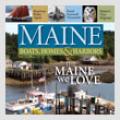A “Lobster Cruiser” Goes to Work
Photos courtesy Michael Martel
 Anna Mary’s plumb bow, flush foredeck and large cockpit were all popular design elements for work and pleasure boats of that era.
Anna Mary’s plumb bow, flush foredeck and large cockpit were all popular design elements for work and pleasure boats of that era.
When my previous boat, a vintage Alden-designed wooden gaff-rigged yawl, was destroyed in a boatyard mishap a few years back, I knew that it would only be a matter of time before I ended up acquiring another boat.
I’m a wooden boat guy, always have been. My Alden was built in 1930 in Thomaston, Maine, by the Robert E. McLain and Sons yard. The McLain family was known for building lobsterboats, a very competitive industry back then, but they also built Friendship sloops and other sailing craft.
It was a common practice in those days for a person to purchase a set of plans for a boat that they wanted, and then contract a yard to build it. That was the case with my Alden, and it turns out, that was the history behind what would become my new boat, as well.
Following the Alden’s demise, I went searching for a replacement, but this time a powerboat, and I ended up with another Thomaston-built wooden boat—a remarkable one-off that was perhaps in many ways the sort of vessel that my grandfather, a boatbuilder himself many years ago, might have chosen for his own. It was listed for sale by Artisan Boatworks in Rockport.
My new boat, Anna Mary, is a 32-foot Lobster Cruiser, built in 1928 by a long-gone company named Gray Boats, and to a very individual design by the remarkable naval architect and master builder Albert E. Condon. Originally named Tollie, she is a single-screw craft, powered by a six-cylinder Ford Lehman diesel. Though roomy and comfortable, simple and spare, she is not ostentatious in any way, but practical and seaworthy. The builder even carefully carved “Gray Boats” into the top of the external rudder’s stock.
Gray Boats was located near present-day Route 1, a bit west of the main part of town. Throughout World War II it built small craft for the Navy and also found time to build the yachts Pilgrim and Puritan for Capt. Ben Pine of Gloucester, Massachusetts, according to one online report. Capt. Pine is the skipper who raced the schooner Gertrude Thebaud against the Canadian schooner Bluenose for the Fisherman’s Trophy. The yard burned down in the late 1940s.
 Anna Mary has a large and open cockpit for family harbor tours of Bristol, Rhode Island.
Anna Mary has a large and open cockpit for family harbor tours of Bristol, Rhode Island.
The boat is a work of art, with complex curves, flared bow, tumblehome, and other design elements that speak of something molded and formed rather than carved out of planks, a testament to the skills of the craftsmen who worked wood back then and to the brilliance of the designer.
Condon, born in 1887, was from Midcoast Maine, and in his lifetime, he designed all types of wooden vessels from cargo carriers to yachts to fishing craft, sail and power, and was equally comfortable with all of them. He was a hard-working, hands-on builder and designer, not content to spend his time solely at the drafting table. I have read that Condon worked for the famous Lawley yard in Neponset, Massachusetts, as well as other high-profile, prestigious yards in different places around New England during his prolific lifetime and career. He preferred to do his own drafting, and to carefully oversee the construction of every craft that had been drawn by his hand. He died in 1963 and his plans are housed at the Mystic Seaport Museum.
Condon described my boat as a “Lobster Cruiser.” I thought this description amusing at first; lobsterboats are working craft for commercial fishing, while a cruiser is typically thought of as a pleasure boat. Yet certain elements that make the Maine lobsterboat a comfortable, seaworthy, workboat make this boat unique and special. You wouldn’t pull traps in Anna Mary, to be sure, but Condon brought together the elements that make a lobstering boat what it is, and softened them to create a stable, dry vessel, ideal for cruising the Maine coast.
Somewhat typical of designs of her time, she has a deep forefoot, a plumb stem, flush deck forward, and a generous, comfortable cockpit.
I found her in 2023, in good shape and stored under a shed to protect her from the elements. According to the broker I worked with, the boat had been maintained for several seasons by Hylan & Brown in Brooklin. I launched Anna Mary in Maine in May, 2024, and cruised south to Bristol, Rhode Island, with plans to run a charter service called Bristol Classic Cruises.
The journey south took four days, most of them in rough conditions, with overnight stops. I can report our Lobster Cruiser lived up to her name as we voyaged south, and she arrived ready to work, taking up to six passengers at a time out to explore the harbor, home to the Herreshoff Museum, and upper Narragansett Bay.
✮
Capt. Mike Martel holds a 100-ton near-coastal Master’s license and delivers power and sail vessels when he’s not working on his own boat restoration. He’s a lifelong marine industry enthusiast, writer, and ex-U.S. Coast Guard seaman, and delivers yachts to Bermuda and the Caribbean, and from Maine to Florida.
Related Articles
Share this article:
2023 Maine Boat & Home Show

Join Us for the Maine Boat & Home Show!
Art, Artisans, Food, Fun & Boats, Boats, Boats
August 11 - 13, 2023 | On the waterfront, Rockland, Maine
Click here to pre-order your tickets.
Show is produced by Maine Boats, Homes & Harbors magazine.















